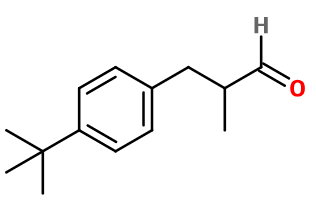
Photo credits: ScenTree SAS
Lilial®
Floral > Light Flowers > Aldehydes > Aquatic > Fresh Flowers
Lysmeral® ; Lilialdéhyde ; Lilestralis® ; Lilyall® ; 3-(4-tert-butylphenyl)butanal ; Aldehyde MBDC ; 2-(4-tert-butyl benzyl) propionaldehyde ; Butyl phenyl methyl propional ; Para-tert-butyl-alpha-methyl hydrocinnamaldehyde ; Para-tert-butyl-alpha-methyl hydrocinnamic aldehyde ; 3-(4-tert-butylphenyl)butanal ; Butylphenylmethylpropional ; Liligul N 743 CLP ; Lilyall ; Mefloral ; Alpha-methyl-beta-(para-tert-butylphenyl)propionaldehyde

Photo credits: ScenTree SAS
| Company | Ingredient Name | ID | Comments | Naturality | Certifications | MOQ | Purity |
|---|---|---|---|---|---|---|---|
|
|
Lilial® - 30gr | - |
Learn more
|
- | - | - | |
|
|
Lysmeral Extra | 30506710 |
Learn more
|
Molecule | - | - | |
|
|
LYSMAL | - |
Learn more
|
- | 10 grs | - |
General Presentation
-
CAS N° :
80-54-6 -
EINECS number :
201-289-8 -
FEMA number :
Donnée indisponible. -
FLAVIS number :
Donnée indisponible.
-
JECFA number :
Donnée indisponible. -
Volatility :
Heart/Base -
Price Range :
€€
Physico-chemical properties
-
Appearance :
Colorless liquid -
Density :
0,939 -
Refractive Index @20°C :
1.503 - 1.506 -
Optical rotation :
Data not available. -
Vapor pressure :
Data not available. -
Flash Point :
79°C (174,2°F)
-
Molecular formula :
C14H20O -
Molecular Weight :
204,31 g/mol -
Log P :
4,2 -
Fusion Point :
-20°C (-4°F) -
Boiling Point :
279°C (534,2°F) -
Detection Threshold :
0,27 ng/l air
Chemistry & Uses
Uses in perfumery :
Lilial® is used in all types of perfumes to give heart to a jasmine, freesia, cyclamen, lotus, lily of the valley or lilac accord.
Year of discovery :
Discovered in 1956. Patent N°2,875,131 published in June, 11 1956 by Carpenter.M, Nutley, Easter W.Jr, Hasbrouck Heights for Givaudan Corporation
Natural availability :
Lilial® is not available in its natural state.
Isomerism :
Lilial® has an asymmetric carbon, giving rise to two possible enantiomers. These two isomers have a similar smell close to lily of the valley.
Synthesis precursor :
Lilial® forms a Schiff base with amines such as Methyl Anthranilate or Indole.
Synthesis route :
Lilial® is prepared in the same way as Cyclamen Aldehyde : a condensation of tert-butylbenzaldehyde (unlike isopropylbenzaldehyde) with propanal, followed by a catalytic hydrogenation of the compound obtained, allows to obtain Lilial®. Another synthetic route exists and consists in a catalytic hydrogenation of alpha-MethylCinnamaldehyde to obtain alpha-methyldihydroCinnamyl Alcohol. Following this first step, an alkylation using tert-butyl chloride or isobutene is operated to obtain a third reaction intermediate, then dehydrogenated to obtain Lilial®.
Stability :
Very unstable in various functional bases.
Aldehydes may form diethylacetals in alcoholic perfumes, with no real impact on their smell.
Most of the time, the occurrence of a benzenic cycle in a molecule causes a coloration of this molecule through time.
Other comments :
Very close to Lyral®. Lilial® is more stable than Cyclamen Aldehyde, for a similar synthetic route.
Lilial® is one of the 26 allergens in perfumery.
IFRA
IFRA 51th :
This ingredient is restricted by the 51th amendment
- Quantitative limit on the use :
-
Cat.1 Cat.2 Cat.3 Cat.4 Cat.5A B C DCat.6 0,0 (Prohibited) 0,09 % 0,04 % 1,4 % 0,06 % 0,05 % 0,05 % 0,017 %0,0 (Prohibited) Cat.5A B C DCat.6 0,06 % 0,05 % 0,05 % 0,017 %0,0 (Prohibited) Cat.7A BCat.8 Cat.9 Cat.10A BCat.11A BCat.12 0,04 % 0,04 %0,017 % 0,1 % 0,1 % 0,63 %0,017 % 0,017 %16 % Cat.10A BCat.11A BCat.12 0,1 % 0,63 %0,017 % 0,017 %16 %
-
Prohibited fragrance ingredients: notes
p-tert-Butyl-α-methylhydrocinnamic aldehyde (p-BMHCA) should not be used for any finished product application included under IFRA Categories 1 and 6 (lipsticks and oral care products).


